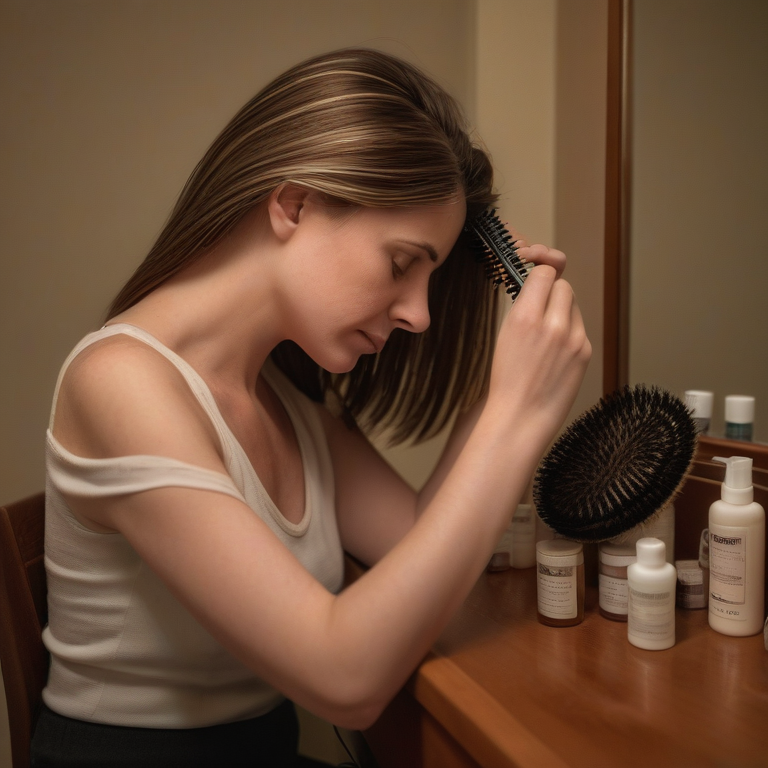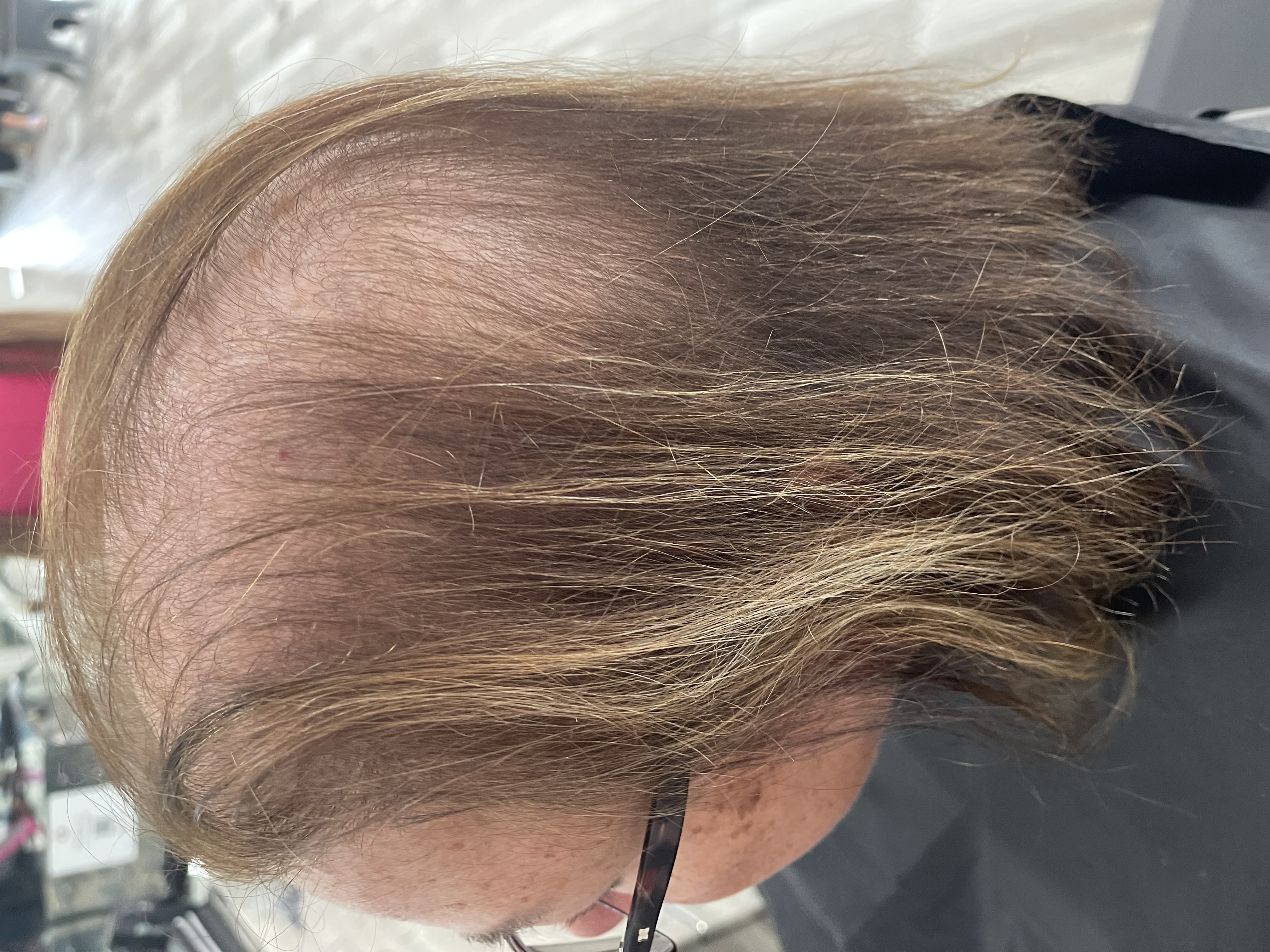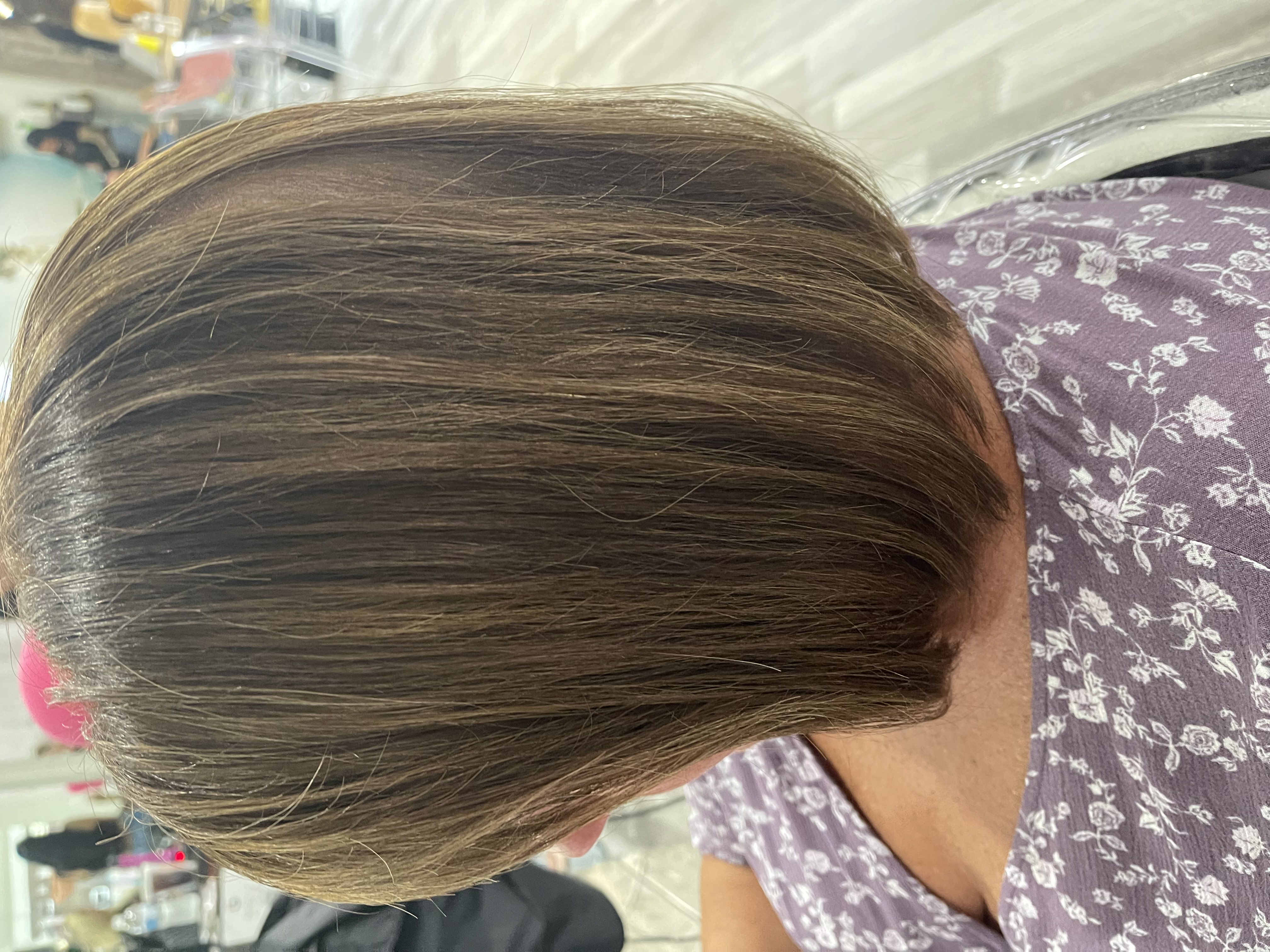Demystifying the Causes of Telogen Effluvium

Key Highlights
- Telogen effluvium (TE) is a common type of hair loss that leads to temporary hair thinning.
- It is triggered by various factors, including stress, hormonal changes, nutritional deficiencies, and certain medical conditions.
- TE arises from a disruption in the normal hair growth cycle, pushing more hair follicles into the resting (telogen) phase.
- Excessive shedding, usually a few months after a triggering event, is a characteristic symptom.
- While usually temporary, understanding the underlying cause and seeking appropriate treatment is crucial for recovery.
Introduction
Experiencing hair loss can be worrisome. However, it’s important to know that not all hair loss is the same. Hair loss is a common issue that affects both men and women. It is usually due to a change in the normal hair growth cycle. This article will focus on telogen effluvium, a type of hair loss that is temporary and typically lasts under 6 months. We will look at what causes it, the treatments you can get, and what recovery looks like, including regrowth to its normal thickness.
Understanding Telogen Effluvium
Telogen effluvium (TE) is a scalp disorder that makes people shed a lot of hair. It can disrupt the usual hair growth cycle for a short time. TE is not like other types of hair loss. It usually happens because of something specific, like stress, illness, or hormonal changes. Even though it can be scary, TE often goes away and can be fixed, especially if it is caused by a temporary stressor or underlying medical condition.
It is important to know how TE is different from other types of hair loss. This helps in getting the right treatment. Seeing a dermatologist or trichologist can lead to finding out the reason for hair loss. They can suggest the best way to manage it.
Defining Causes of Telogen Effluvium in the Context of Hair Loss
Telogen effluvium is when hair thins out all over rather than in specific spots. This type of hair shedding happens due to something inside or outside the body that affects the normal hair growth cycle.
Doctors often divide telogen effluvium into two types: acute and chronic. Acute telogen effluvium is short-term and lasts less than six months. In contrast, chronic telogen effluvium goes on for more than six months and can change over time.
It's also important to tell telogen effluvium apart from anagen effluvium, another kind of hair loss. Telogen effluvium happens to hair that is in the resting phase, while anagen effluvium affects hair that is actively growing. Anagen effluvium is often caused by treatments like chemotherapy or radiation therapy.

The Science Behind the Hair Growth Cycle and TE's Impact
A single hair follicle goes through cycles of growth, change, and rest. These cycles include the anagen phase (growth), catagen phase (change), and telogen phase (rest). These phases affect how long and thick our hair is.
Telogen effluvium disrupts the normal balance of these phases. Normally, about 85% of hair follicles are in the anagen phase, while only 15% are in the telogen phase.
When stress, illness, or other factors occur, more hair follicles may enter the telogen phase too early. This early change causes excessive shedding. People may notice hair thinning or more hair loss as a result.
Identifying the Triggers of Telogen Effluvium
Finding the main causes of TE is important for successful treatment. Some cases have no known cause, but many common triggers can be found. By knowing and dealing with these triggers, we can help manage TE and possibly stop it from coming back.
Common triggers include stress from emotions or physical exertion, changes in hormones like those after giving birth or during menopause, lack of proper nutrition, specific medicines, and other health issues.
The Role of Stress in Triggering TE
Life's daily stress can come from work deadlines or problems in relationships. Usually, these stressors do not greatly affect the body. But if stress lasts a long time or becomes very strong, it can show up in physical ways. This includes issues with hair growth.
Emotional stress can throw off the regular hair cycle. It can cause hair follicles to move into the telogen phase too soon, which means extra shedding may happen a few months later. This slow response can make it hard to say for sure that stress is the cause.
Severe stress from traumatic events like accidents, surgeries, or losing someone can also lead to temporary hair loss. In such cases, the shock can cause big changes in the hair growth cycle, leading to a lot of hair loss.
Nutritional Deficiencies and Their Contribution to TE
Our hair needs many nutrients to grow healthy and strong. These include proteins, vitamins, and minerals. If our body does not get enough of these nutrients, especially iron, it can affect how hair follicles work.
A diet that lacks essential nutrients can cause TE, which leads to excessive hair shedding. While many deficiencies can result in hair loss, iron deficiency is often the main problem. Iron is important because it helps deliver oxygen to the hair follicles. Without enough iron, hair growth can slow down.
Fixing nutritional deficiencies usually means changing our diet. We may also need to take specific vitamins and minerals. Consulting with a healthcare professional or a registered dietitian can help us find out which deficiencies we have. They can also suggest the best steps to take next.
How Hormonal Changes Induce TE
Hormones are chemicals that send messages in the body. They help control many functions, including hair growth. Changes in hormone levels can happen during childbirth, menopause, or when there are thyroid problems. These changes can cause temporary hair loss, known as TE.
Pregnancy is a happy time, but it can also change a woman's hormones. This often leads to postpartum hair loss, a common form of TE. Similarly, hormonal changes during menopause can also result in TE.
Aside from these major life events, other health issues that cause hormone imbalances, like thyroid disorders, can lead to hair loss. Finding and treating any hormone problems with medication or changes in lifestyle can help control TE effectively.
Telogen Effluvium Symptoms and Diagnosis
Recognizing the early signs of TE can greatly help in managing it well. If you think you have TE, it’s important to see a dermatologist or trichologist. They can diagnose it accurately and check for other reasons for hair loss.
Getting a quick diagnosis can ease worries about hair loss. It also allows for prompt treatment that may lessen hair thinning and speed up recovery.
Recognizing the Signs of TE
One of the most common signs of TE is excessive hair shedding. This means you might see more hair than usual on brushes, pillows, or in the shower drain. The shedding can happen all over your scalp or be worse in certain spots.
People with TE may also notice their hair is thinning. This means their hair may feel less thick than normal. Sometimes, this thinning happens slowly, so it can be hard to notice at first.
Another clear sign is "club hairs." These are hairs with a small white tip at the root. Club hairs are basically telogen hairs that have come out of the hair follicles too soon.
Diagnostic Techniques for Confirming TE
Diagnosing telogen effluvium involves several steps. First, a doctor takes a detailed medical history of the patient. Then, they do a physical examination of the scalp. There are also specific tests to confirm the diagnosis and rule out other causes of hair loss.
One common test is the "pull test." During this test, a dermatologist pulls a small section of hair gently. They check how easily the hair comes out of the scalp. If many hairs fall out, it could mean telogen effluvium.
Another helpful test is a scalp biopsy. This is where a small piece of scalp tissue is taken. It is examined under a microscope to look at the number of hair follicles and their growth phases.
|
Diagnostic Test |
Description |
|
Pull Test |
Gently pulling a small bunch of hair to check for shedding. A positive result could signify telogen effluvium. |
|
Scalp Biopsy |
Looking closely at a small sample of scalp tissue to examine hair follicle activity. |
Comprehensive Treatment Strategies for Telogen Effluvium
Most cases of telogen effluvium are temporary. They usually get better on their own once the main cause is fixed. Treatment often includes lifestyle changes. It may also involve treating any medical problems and sometimes using medicine to help hair grow back.
It's important to treat it in a complete way. This means focusing on your overall health and the specific causes. This approach can help prevent it from happening again and keep your hair healthy.
Lifestyle Adjustments to Mitigate TE
Incorporating a few lifestyle changes can really help manage hair loss. These changes may seem small, but they can create a better environment for hair growth and stop future problems.
First, it’s important to eat a balanced diet. This diet should be full of nutrients, vitamins, and minerals, especially iron. Getting enough protein is key because hair is mainly made of a protein called keratin.
Using stress management techniques can also help. Activities like exercise, yoga, meditation, and getting enough sleep can help keep hormone levels in check and reduce stress-related hair loss. Plus, avoiding harsh hair treatments, like too much heat styling, tight hairstyles, and strong chemical products can help those with hair loss.
Medical Treatments and Their Efficacy in TE Recovery
Making changes to your lifestyle and dealing with the main causes can usually help manage hair thinning. But sometimes, dermatologists might suggest medical treatments to speed up recovery and reduce hair loss.
Minoxidil is a common medicine that comes as a topical treatment to help with hair growth. You can buy it without a prescription, and it is generally safe for both men and women.

Recovery and Management of Telogen Effluvium Regrowth
Understanding how TE recovery works and using helpful management tips can give you comfort when waiting feels hard. Remember, hair regrowth doesn’t happen overnight. You need to stay consistent.
Recovering from TE takes time. You may not see results for several months. Be patient as new hair strands grow. They will slowly get longer and help fill in any thinning spots.
During this time, it’s best to be gentle with your hair. Use a wide-toothed comb to avoid pulling. Stay away from tight hairstyles that can cause more stress. Try to limit heat styling and chemical treatments to keep your hair safe and healthy.

What to Expect During the TE Recovery Process
The best sign during recovery from hair loss is new hair growth. These new hairs may start off short and fine, making them hard to see. But with regular care and by handling any causes, this new hair will become thicker and stronger over time.
At first, as the new hair appears, people may go through a "shedding" phase. During this time, some hairs may fall out to make room for new growth. This shedding is actually a good sign. It shows that the hair follicles are getting back to their normal cycle.
It’s important to note that everyone recovers at different speeds. The level of hair loss, overall health, and how well treatments work can all affect how quickly recovery happens.
Long-term Management Strategies for TE
Once the early shedding stops, the focus moves to ways to keep the scalp healthy and reduce the chance of future TE episodes. This means sticking with any lifestyles changes that were suggested and getting help from professionals if there are any possible triggers.
It's important to check your hair health often. You should get medical help right away if you notice too much shedding or any changes in your scalp. This can stop more serious or long-lasting cases of TE.
Following a healthy diet full of nutrients good for hair, handling stress well, and avoiding triggers you know are a problem are all important. This is true even when the hair growth goes back to normal. Remember, being consistent is very important for keeping your hair and scalp strong over time.

Conclusion
Telogen Effluvium can be a hard condition to deal with. However, knowing what causes it and how to treat it is important for getting better. Common causes include stress, not getting enough nutrients, and hormonal changes. These factors can affect the hair growth cycle. Making lifestyle changes and getting medical help are very important for handling TE. The time it takes to recover can be different for everyone. Long-term care is also important for lasting results. If you or someone you know has signs of TE, it's best to get a professional diagnosis and advice. Keeping in mind that patience and a complete approach are key can help when dealing with Telogen Effluvium.
Frequently Asked Questions
What Is the Typical Duration of Telogen Effluvium?
Acute telogen effluvium usually lasts less than six months. In some cases, it can continue for years. People with this condition often see hair shedding on the entire scalp, which causes overall thinning of their hair.




